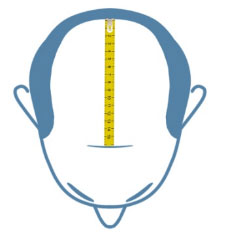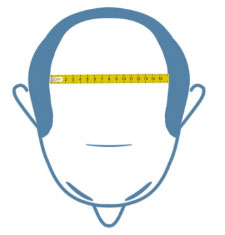A hair patch typically lasts anywhere from 2 to 6 months, depending on factors like material quality, maintenance, and lifestyle. Human hair patches tend to last longer than synthetic ones. In this article, we'll explore how long hair patches last, tips to extend their lifespan, common issues, and when to replace them.
What is a Hair Patch?
A hair patch is a non-surgical solution designed to cover bald spots or thinning hair, offering a temporary way to restore a full head of hair.
It’s typically made of either synthetic fibers or natural human hair, and it adheres to the scalp through adhesives or clips. Hair patches can be customized to match the color, texture, and density of your natural hair, creating a seamless and natural look.
They’re popular among people who want to avoid the time, cost, or commitment involved in permanent hair loss treatments like hair transplants. Whether you're looking for a temporary fix or a more long-term solution, hair patches offer an effective and relatively easy way to address hair loss.
How Long Does a Hair Patch Last?
The lifespan of a hair patch depends largely on the type of materials used, the quality of the patch, and how well it is maintained.
On average, a hair patch made of synthetic fibers typically lasts between 2 to 4 months, while one made from human hair can last anywhere from 3 months to 6 months or more, depending on how it’s cared for.
Factors Affecting Lifespan
Material Quality: High-quality synthetic hair patches tend to last longer than lower-quality options. Human hair patches also tend to last longer and can be treated like natural hair, meaning they may hold up better with proper care.
Maintenance: Proper care is key to extending the lifespan of your hair patch. If you don’t follow a proper cleaning and maintenance routine, your patch may wear out faster.
Lifestyle: Regular exposure to sweat, oils, or moisture from activities like swimming or exercising can degrade a hair patch faster. Those who are more active might need to replace their patches more frequently.
Usage Frequency: If you're wearing the patch every day, it will naturally experience more wear and tear than if you only wear it occasionally for special occasions.
_1.jpg)
How to Extend the Lifespan of Your Hair Patch
Clean Regularly
Just like natural hair, hair patches need to be cleaned regularly. Use a gentle shampoo and conditioner to remove dirt and oils. Be sure to follow the specific cleaning instructions for the type of hair patch you have to avoid damage.
Store Properly
When you're not wearing your hair patch, make sure to store it in a safe place, away from direct sunlight or excessive heat. A storage bag or box can help protect it from dust and potential damage.
Handle with Care
Be gentle when handling your hair patch. Avoid pulling or tugging on it, as this can cause the fibers to weaken or the adhesive to loosen.
Choose Quality Products
Invest in a high-quality patch. While it may cost a bit more upfront, a premium hair patch will last longer and provide a more natural appearance, making it worth the investment in the long run.
Common Issues with Hair Patches
While hair patches are a great solution for many, they do come with a few potential issues that users might face:
Adhesive Wear and Tear
One of the most common problems with hair patches is the adhesive losing its grip over time. This can result in the patch slipping or becoming loose.
To fix this, you’ll need to regularly reapply the adhesive or opt for a patch with stronger, longer-lasting adhesives.
Color Fading
If you wear your hair patch frequently, it may start to lose its color due to exposure to sunlight, hair products, or washing.
Some synthetic patches may fade quicker than natural hair patches. If this happens, you may need to dye your hair patch or replace it altogether.
Shedding
Like natural hair, hair patches may shed over time, especially if they are made of synthetic fibers.
Regular cleaning and proper care can help minimize shedding, but it’s normal to experience some amount of hair loss from the patch as it ages.

When to Replace Your Hair Patch
Knowing when to replace your hair patch can save you time and frustration. Here are some signs that it’s time for a new one:
Thinning or Shedding
If the patch starts to lose hair or becomes noticeably thinner, it might be time to replace it. This can occur with both synthetic and human hair patches, especially if they’re worn frequently.
Damage to the Patch
If the hair patch is torn, frayed, or the adhesive is no longer holding it in place, it’s time to replace it.
Continuing to wear a damaged patch can make it look unnatural and less effective.
Loss of Natural Appearance
Over time, a patch may start to look unnatural due to color fading, wear, or the buildup of hair products. If your patch no longer matches the color or texture of your natural hair, it might be time to upgrade.
Conclusion
A hair patch is a quick and easy solution to hair loss, offering flexibility and convenience for those looking to restore their hair without undergoing surgery.
With proper care, a high-quality hair patch can last several months, but it’s important to be mindful of factors like lifestyle, maintenance, and usage frequency to extend its lifespan.
Regular cleaning, proper storage, and gentle handling will ensure that your hair patch remains in good condition and continues to provide a natural look for as long as possible. Keep an eye on the signs that it’s time for a replacement, and don’t hesitate to invest in a new patch when necessary to maintain your confidence and appearance.
If you’re looking for a high-quality hair patch, visit Lavivid Hair, where we offer custom hair systems designed to suit your specific needs. Our expert team is here to help you find the perfect solution for your hair restoration journey.
More Reading: How Long Do Your Hair Systems Last?




Comments (0)